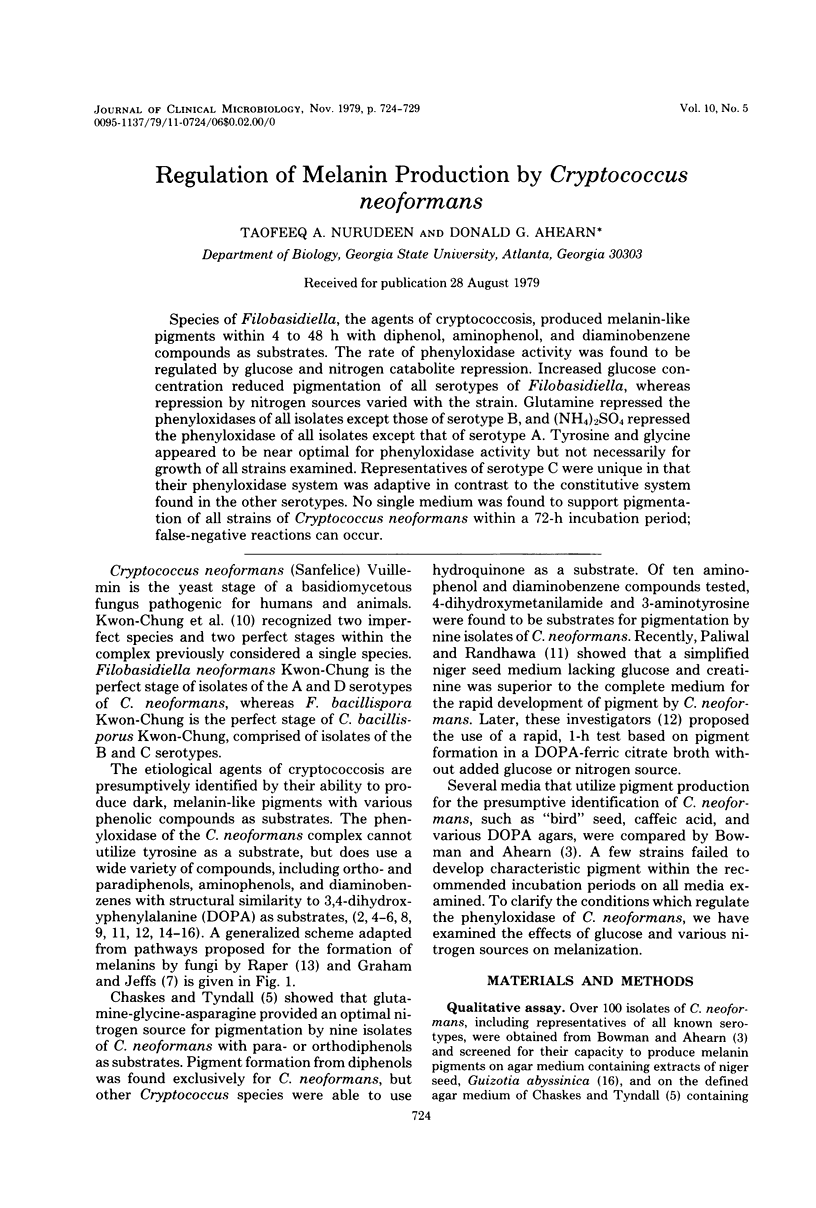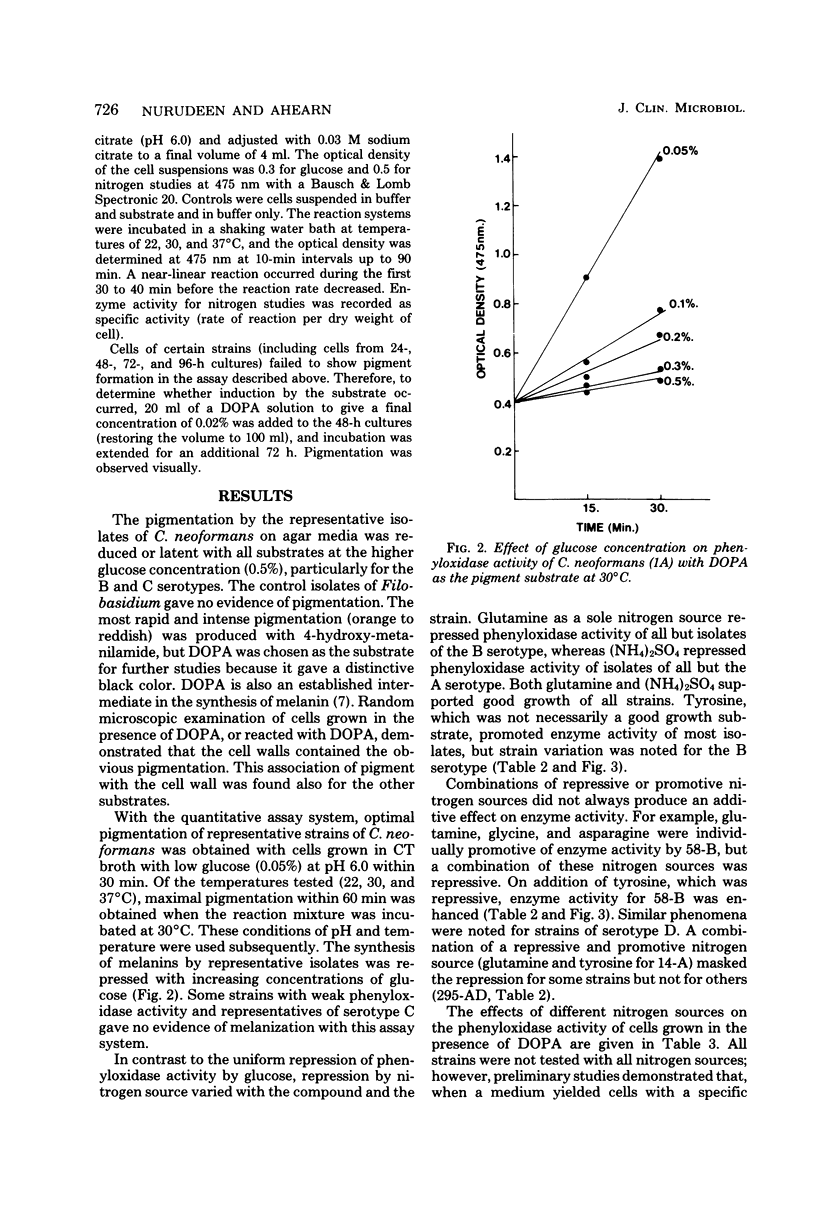Abstract
Species of Filobasidiella, the agents of cryptococcosis, produced melanin-like pigments within 4 to 48 h with diphenol, aminophenol, and diaminobenzene compounds as substrates. The rate of phenyloxidase activity was found to be regulated by glucose and nitrogen catabolite repression. Increased glucose concentration reduced pigmentation of all serotypes of Filobasidiella, whereas repression by nitrogen sources varied with the strain. Glutamine repressed the phenyloxidases of all isolates except those of serotype B, and (NH4)2SO4 repressed the phenyloxidase of all isolates except that of serotype A. Tyrosine and glycine appeared to be near optimal for phenyloxidase activity but not necessarily for growth of all strain examined. Representatives of serotype C were unique in that their phenyloxidase system was adpative in contrast to the constitutive system found in the other serotypes. No single medium was found to support pigmentation of all strains of Cryptococcus neoformans within a 72-h incubation period; false-negative reactions can occur.
Full text
PDF





Selected References
These references are in PubMed. This may not be the complete list of references from this article.
- Bennett J. E., Kwon-Chung K. J., Theodore T. S. Biochemical differences between serotypes of Cryptococcus neoformans. Sabouraudia. 1978 Sep;16(3):167–174. [PubMed] [Google Scholar]
- Botard R. W., Kelley D. C. Modified Littman oxgall agar to isolate Cryptococcus neoformans. Appl Microbiol. 1968 May;16(5):689–690. doi: 10.1128/am.16.5.689-690.1968. [DOI] [PMC free article] [PubMed] [Google Scholar]
- Breyer D., Staib F., Senska M., Blisse A. Uber die Eignung des O-Diphenoloxydasenachweises mit Brenzcatechin zur Differenzierung von Cryptococcus neoformans. Zentralbl Bakteriol Orig A. 1972 Dec;222(4):540–543. [PubMed] [Google Scholar]
- Chaskes S., Tyndall R. L. Pigment production by Cryptococcus neoformans and other Cryptococcus species from aminophenols and diaminobenzenes. J Clin Microbiol. 1978 Feb;7(2):146–152. doi: 10.1128/jcm.7.2.146-152.1978. [DOI] [PMC free article] [PubMed] [Google Scholar]
- Chaskes S., Tyndall R. L. Pigment production by Cryptococcus neoformans from para- and ortho-Diphenols: effect of the nitrogen source. J Clin Microbiol. 1975 Jun;1(6):509–514. doi: 10.1128/jcm.1.6.509-514.1975. [DOI] [PMC free article] [PubMed] [Google Scholar]
- Graham D. G., Jeffs P. W. The role of 2,4,5-trihydroxyphenylalanine in melanin biosynthesis. J Biol Chem. 1977 Aug 25;252(16):5729–5734. [PubMed] [Google Scholar]
- Hopfer R. L., Gröschel D. Six-hour pigmentation test for the identification of Cryptococcus neoformans. J Clin Microbiol. 1976 Aug;2(2):96–98. [PMC free article] [PubMed] [Google Scholar]
- Korth H., Pulverer G. Pigment formation for differentiating Cryptococcus neoformans from Candida albicans. Appl Microbiol. 1971 Mar;21(3):541–542. doi: 10.1128/am.21.3.541-542.1971. [DOI] [PMC free article] [PubMed] [Google Scholar]
- Paliwal D. K., Randhawa H. S. A rapid pigmentation test for identification of Cryptococcus neoformans. Antonie Van Leeuwenhoek. 1978;44(2):243–246. doi: 10.1007/BF00643226. [DOI] [PubMed] [Google Scholar]
- Paliwal D. K., Randhawa H. S. Evaluation of a simplified Guizotia abyssinica seed medium for differentiation of Cryptococcus neoformans. J Clin Microbiol. 1978 Apr;7(4):346–348. doi: 10.1128/jcm.7.4.346-348.1978. [DOI] [PMC free article] [PubMed] [Google Scholar]
- Raper H. S. The Tyrosinase-tyrosine Reaction: Production from Tyrosine of 5: 6-Dihydroxyindole and 5: 6-Dihydroxyindole-2-carboxylic Acid-the Precursors of Melanin. Biochem J. 1927;21(1):89–96. doi: 10.1042/bj0210089. [DOI] [PMC free article] [PubMed] [Google Scholar]
- Shaw C. E., Kapica L. Production of diagnostic pigment by phenoloxidase activity of cryptococcus neoformans. Appl Microbiol. 1972 Nov;24(5):824–830. doi: 10.1128/am.24.5.824-830.1972. [DOI] [PMC free article] [PubMed] [Google Scholar]
- Shields A. B., Ajello L. Medium for selective isolation of Cryptococcus neoformans. Science. 1966 Jan 14;151(3707):208–209. doi: 10.1126/science.151.3707.208. [DOI] [PubMed] [Google Scholar]
- Staib F., Senska M. Der Braunfarbeffekt (BFE) bei Cryptococcus neoformans auf Guizotia abyssinica-Kreatinin-Agar in Abhängigkeit vom Ausgangs-pH-Wert. Zentralbl Bakteriol Orig A. 1973 Oct;225(1):113–124. [PubMed] [Google Scholar]
- Strachan A. A., Yu R. J., Blank F. Pigment production of Cryptococcus neoformans grown with extracts of Guizotia abyssinica. Appl Microbiol. 1971 Sep;22(3):478–479. doi: 10.1128/am.22.3.478-479.1971. [DOI] [PMC free article] [PubMed] [Google Scholar]


